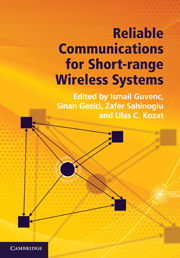Book contents
- Frontmatter
- Contents
- List of contributors
- 1 Short-range wireless communications and reliability
- Part I High-rate systems
- Part II Low-rate systems
- 6 ZigBee networks and low-rate UWB communications
- 7 Impact of channel estimation on reliability
- 8 Interference mitigation and awareness for improved reliability
- 9 Characterization of Wi-Fi interference for dynamic channel allocation in WPANs
- 10 Energy saving in low-rate systems
- Part II Selected topics for improved reliability
- Index
7 - Impact of channel estimation on reliability
from Part II - Low-rate systems
Published online by Cambridge University Press: 01 June 2011
- Frontmatter
- Contents
- List of contributors
- 1 Short-range wireless communications and reliability
- Part I High-rate systems
- Part II Low-rate systems
- 6 ZigBee networks and low-rate UWB communications
- 7 Impact of channel estimation on reliability
- 8 Interference mitigation and awareness for improved reliability
- 9 Characterization of Wi-Fi interference for dynamic channel allocation in WPANs
- 10 Energy saving in low-rate systems
- Part II Selected topics for improved reliability
- Index
Summary
This chapter discusses the impacts of channel estimation on the reliability of ultrawideband (UWB) systems when path delays and path amplitudes are jointly estimated [1]. The Cramér–Rao bound (CRB) for the path delay estimates is presented as a function of the signal-to-noise ratio (SNR) and signal bandwidth. The performance of a UWB system employing a Rake receiver and maximal ratio combining (MRC) is analyzed taking into account estimation errors as predicted by the CRB. Expressions for the bit error rate (BER) are obtained displaying the effects of the number of pilot symbols and the number of multipath components on the overall system performance. Transceiver design issues, such as allocation of power resources to pilot symbols, signal bandwidth, and the number of diversity paths (fingers) used at the receiver, are discussed in the context of the effects of estimation errors. Allocations of power resources to pilot symbols are determined to optimize the BER. Finally, the estimation errors are taken into account to optimize the signal bandwidth and the number of fingers of the Rake receiver in UWB systems.
Introduction
One of the most attractive features of UWB is its ability to resolve multipath. Numerous investigations have confirmed that the UWB channel can be resolved into a significant number of distinct multipath components [2–4]. A Rake receiver with MRC can be employed in UWB systems to exploit the multipath diversity. However, Rake receivers require knowledge of multipath delays and amplitudes.
- Type
- Chapter
- Information
- Reliable Communications for Short-Range Wireless Systems , pp. 168 - 189Publisher: Cambridge University PressPrint publication year: 2011



